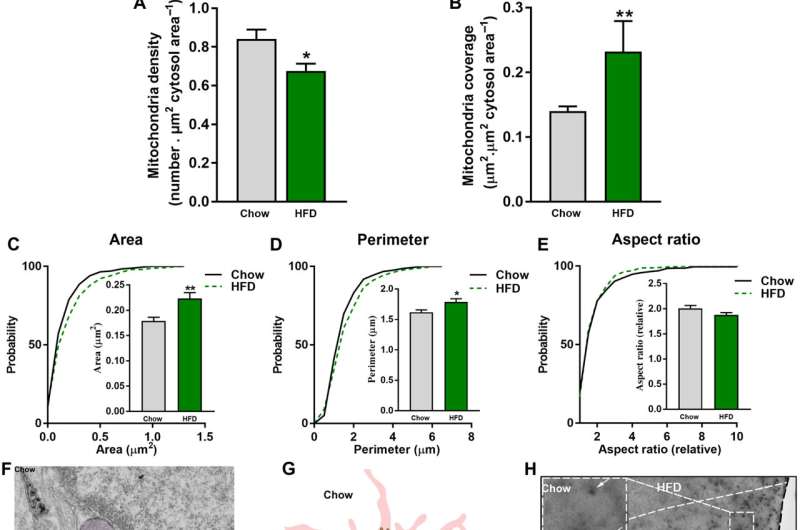Brain cell's ability to use fat determines weight gain in mice

Like the body itself, cells within the body of living animals require fuel for energy, but it's not always known how different fuel sources affect the function of those cells. Astrocytes, a type of brain cell, for instance, can use both glucose and fatty acids for fuel. But just how fatty acids affect astrocyte function—and the brain pathways they are connected with—is not well understood.
In a study published Dec. 10 in Science Advances, Yale researchers reveal the effects of fatty acids on astrocyte function and how they are mediated by diet. These insights, they say, could help identify a potential target for treating obesity and Type 2 diabetes.
In a study on mice, a research team in Yale's Department of Comparative Medicine looked specifically at a brain pathway that helps control satiety, or the feeling of being full after eating. Like in humans, when a mouse eats, neurons in an area of their brain known as the hypothalamus start to fire, sending a signal of "satiation," and theoretically causing them to stop eating. Astrocytes interact with these neurons, helping to deliver that signal.
The astrocytes' ability to support these neurons, however, depends on the fuel they can access, the researchers say. If astrocytes can use fatty acids, then astrocytes help neurons signal satiety. The ability to utilize fatty acids for this purpose, however, is highly contingent on diet. When mice consumed a high-fat diet, the researchers found that astrocytes were not able to use fatty acids for fuel, limiting the neurons' ability to signal satiety, and ultimately promoting weight gain.
"So, fat itself is protecting mice from gaining weight on a high-fat diet, but only as long as fat can enter astrocytes," said Tamas Horvath, the Jean and David W. Wallace Professor of Comparative Medicine at Yale School of Medicine and senior author of the study. "Astrocytes' ability to use fat determines a mouse's susceptibility to diet-induced obesity."
In their research, Horvath and his colleagues uncovered the roles of two main players in this process. The molecule ANGPTL4 (Angiopoietin-like 4), they say, reduces the availability of fatty acids. But when mice were fed a high-fat diet, this molecule became overactive, leading to a reduction in the fatty acids that were available for astrocytes to use and, eventually, weight gain. When the researchers suppressed ANGPTL4 function, however, the mice remained lean even when they were fed a high-fat diet. This, the scientists concluded, was due to the activity of another molecule called PPARγ(peroxisome proliferator-activated receptor gamma).
"PPARγ is the machinery that enables fats to be used by astrocytes," said Horvath. "Removing ANGPTL4 leads to more PPARγ activation."
And with more PPARγ activation, he said, there are more fatty acids for astrocytes to use and a reduced likelihood of gaining weight.
Understanding how these molecules affect astrocyte function and, ultimately, weight gain may help researchers target them for treatment of certain health conditions. Horvath notes that weight gain itself is not a threat to health; complications that can arise from weight gain, such as Type 2 diabetes and cardiovascular issues, are.
"Hypothetically, we can target this cellular machinery to promote fat uptake by astrocytes and, through that, prevent weight gain and the dangerous comorbidities that can come with it," he said.
More information: Luis Varela et al, Astrocytic lipid metabolism determines susceptibility to diet-induced obesity, Science Advances (2021). DOI: 10.1126/sciadv.abj2814


















